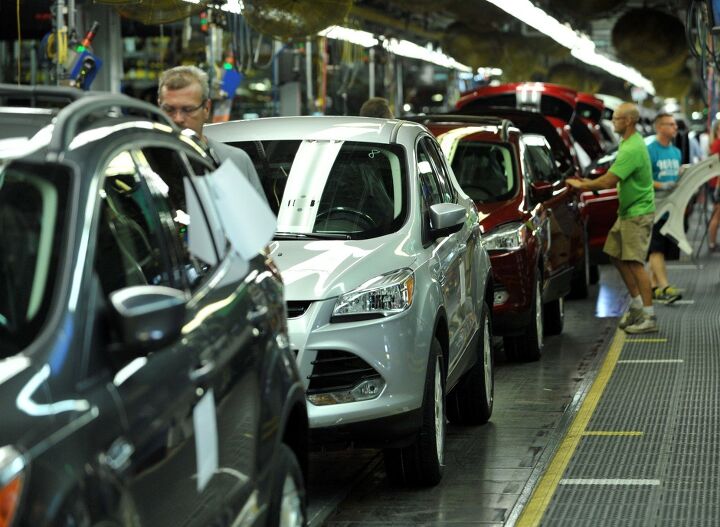Ford Tries To Increase North American Capacity, Escape & Fusion in High Demand, Short Supply
After adding 600,000 units to its North American capacity within the past two years, Ford is trying to find ways to increase output of the Escape crossover and midsize Fusion, both of which currently have about 40 days supply. The Fusion is particularly in short supply on the east and west coasts, a good sign for any domestic automaker these days. A 60 day supply of cars in inventory is generally considered normal for the U.S. auto industry. Automotive News is reporting that at the Center for Automotive Research’s Management Briefing Seminars, held in Traverse City, Michigan, Ford VP for North America manufacturing, Jim Tetreault, said, “We’re still looking at how we get more out of every plant, and that’ll be a focus for as long as the demand is as strong as it is.”
One option is adding a third shift at the Flat Rock Assembly Plant, which currently builds Mustangs and a second shift is being added to start building Fusions. Adding capacity at the Louisville Assembly Plant, where the Escape is put together, will be done by speeding up the assembly line. Tetreault said that increasing speed by 2 Escapes an hour would give the automaker another 240 vehicles a week to sell. He said that squeezing out even one more car or light truck an hour would be worthwhile.
So far, Ford has used a combination of adding shifts and increased use of relief and floating employees to keep the lines humming at its 30 plants in North America. The automaker also has twice weekly meetings including manufacturing and purchasing managers along with “supplier technical assistance leaders” to look for capacity improvements. Another area of improvement has been through better equipment maintenance. Ford says that production was improved by 3% just by “better up-time” and new equipment purchases. Attention to ergonomics on the assembly line is also expected to yield greater productivity. Employee health, both reducing on the job injuries and identifying employees at risk for chronic illnesses and providing them with health advice, is also seen as a means of improving capacity by reducing absenteeism.
Ford has been increasing its human resources, with 8,000 hourly and 3,000 salaried employees hired within the last 5 quarters. That leaves Ford with a current total of 82,300 workers in North America. Tetreault doubted that Ford will ever see the kind of employment levels it had before the recession, even with continued growth in the U.S. market.
More by TTAC Staff
Latest Car Reviews
Read moreLatest Product Reviews
Read moreRecent Comments
- El scotto Under NAFTA II or the USMCA basically the US and Canada do all the designing, planning, and high tech work and high skilled work. Mexico does all the medium-skilled work.Your favorite vehicle that has an Assembled in Mexico label may actually cross the border several times. High tech stuff is installed in the US, medium tech stuff gets done in Mexico, then the vehicle goes back across the border for more high tech stuff the back to Mexico for some nuts n bolts stuff.All of the vehicle manufacturers pass parts and vehicles between factories and countries. It's thought out, it's planned, it's coordinated and they all do it.Northern Mexico consists of a few big towns controlled by a few families. Those families already have deals with Texan and American companies that can truck their products back and forth over the border. The Chinese are the last to show up at the party. They're getting the worst land, the worst factories, and the worst employees. All the good stuff and people have been taken care of in the above paragraph.Lastly, the Chinese will have to make their parts in Mexico or the US or Canada. If not, they have to pay tariffs. High tariffs. It's all for one and one for all under the USMCA.Now evil El Scotto is thinking of the fusion of Chinese and Mexican cuisine and some darn good beer.
- FreedMike I care SO deeply!
- ClayT Listing is still up.Price has been updated too.1983 VW Rabbit pickup for sale Updated ad For Sale Message Seller [url=https://www.vwvortex.com/members/633147/] [/url] jellowsubmarine 0.00 star(s) (0.0) 0 reviews [h2]$19,000 USD Check price[/h2][list][*] [url=https://www.ebay.com/sch/i.html?_nkw=1983 VW Rabbit pickup for sale Updated ad] eBay [/url][/*][/list] Ceres, California Apr 4, 2024 (Edited Apr 7, 2024)
- KOKing Unless you're an employee (or even if you are) does anyone care where physically any company is headquartered? Until I saw this story pop up, I'd forgotten that GM used to be in the 'Cadillac Building' until whenever it was they moved into RenCen (and that RenCen wasn't even built for GM). It's not like GM moved to Bermuda or something for a tax shelter (and I dunno maybe they ARE incorporated there legally?)
- Fred It just makes me question GM's management. Do they save rent money? What about the cost of the move? Don't forget they have to change addresses on their forms. New phone numbers? Lost hours?

































Comments
Join the conversation
Well, I guess that explains the casual fit of the body panels...
Would not touch a Ford with a 10 ft pole. Crappy company and crappy cars. Friend's dad had a 2 year old Fusion in the shop for 2 months straight. Ford refused to lemon the car and only reimbursed for one month of his payments. He was going to buy the new MKZ, instead he bought a new, fully loaded Azera with the tech package and loves it. He will never touch a Ford again. There are so many recalls and problems with Fords it is not funny.